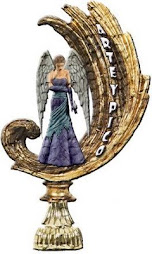
Today is St. Valentine's Day, but no one is really sure who this St. Valentine was. He may have been a Roman priest martyred during the reign of the Emperor Claudius in the mid third century, or he may have been the bishop of Terni, who was taken to Rome and martyred and whose remains were returned to Terni. The feast of St. Valentinus was once on the Roman calendar but he was dropped quite a while back, and now his day is more of a "Hallmark Holiday" a holiday for selling greeting cards, flowers, and chocolates.
Today is also the Feast of Saints Cyril and Methodius, two very important saints. Cyril and Methodius were brothers and lived in Thessalonica, a town where Christians were gathering very early in the history of the Church. Methodius was born around the year 815 and his brother Constantine was born around the year 826. Constantine studied philosophy and later became a monk, taking on the name of Cyril. As a philosophy student, Cyril also studied languages and was well-versed in Hebrew, Arabic, and even the Samaritan dialect. In the year 860, Photius, the patriarch of Constantinople selected Cyril and Methodius as the first missionaries to the Slavs. He chose them not only because Cyril was good with languages, but because as children both brothers spent a lot of time around the Slavs who lived in Thessalonica; they learned the Slavic language and were fluent in that language. They were the natural choice to be missionaries to the Slavs. Their first missionary trip in 860 was to the Khazars who lived north of the Caucasus region, but it was unsuccessful and the Khazars actually ended up accepting Judaism instead of Christianity. In the year 863, Rostislav, prince of Moravia (which is the area we now call the Czech Republic), requested Christian missionaries be sent. He had one requirement: that the missionaries be able to preach to the people in their own language and must do services in Slavonic, which meant that they needed Bibles and service books in Slavonic. So, before they even left for Moravia, the brothers started translating the Bible into Slavonic. There was not actual Slavonic alphabet so they had to invent one with which they would write their translations of the Bible and prayer books. The alphabet invented by St. Cyril is called Glagolithic and his followers invented another alphabet called Cyrillic which is the alphabet used in Russia and the former Eastern Block nations to this day. They translated the Bible into the dialect they had learned as boys, a Macedonian dialect of slavonic spoken around Thessalonica, an this language is now called Church Slavonic, and it is the liturgical language of the Russian Orthodox Church and the Slavonic Orthodox Churches. This is very important, because the Slavs were one of the few peoples who heard the gospel read in their own language instead of Greek or Latin, the major languages of the Church at that time. The Roman church always insisted that everything be done in Latin, but the Eastern church felt that it was important that services and readings be done in the vernacular of the people, the same concept which is accepted in the Anglican Communion. Cyril and Methodius ran into some trouble in Moravia and in Bulgaria; the Church in the West had sent German missionaries and they did not like the Greek Orthodox monks working in their area. The brothers were doing services in the language of the people while the Germans did everything in Latin; the brothers recited the Nicene Creed in its Eastern form without the filioque. In order to end German interference with the mission, Cyril asked for the protection of the Pope as he really didn't get involved in the East-West arguments and the Church was still united at that time; Cyril just wanted to continue working in Slavonic. The brothers traveled to Rome in 868 to speak to Pope Hadrian II, and he received them favorably and gave full support to their mission, allowing them to work in Slavonic, and even approved their translations of the Bible and service books. Unfortunately, Cyril died in Rome in 869, and when Methodius returned to Moravia, the Germans ignored the Pope's decision and obstructed him in every way; they even put Methodius in prison for a year!
When Methodius died in the year 885, the Germans ran his followers out of the country and even sold some of them into slavery (fine Christian people!). The Slavonic church lasted there for another two hundred years but then vanished; it seemed as if the mission of Cyril and Methodius had failed. but while their mission died in Moravia their translations moved in to Bulgaria, Serbia, and Russia, and Church Slavonic is the liturgical language of those areas. The Church grew and spread throughout that area and even lasted through fifty years of Communist oppression.
Some of the issues that Cyril and Methodius dealt with are still important today and are even important to us here in Panama. The issue of language is a very important issue here. I think that what saints Cyril and Methodius taught us is that it is important that people hear the gospel and worship in the language with which they are familiar, whether that language be English, Español, or Slavonic. When people hear the gospel in their own language the church takes root and grows. Cyril knew that it was important that the peoples of the Caucasus hear the Word in their own words and he was willing to go to those who spoke Latin to get the support he needed, because he knew that the Church is large enough to include everybody, whether they speak Español, English, Nippon-go, Hungarian, Greek or Slavonic, God hears us no matter what language we speak. What is important is that we remember that we are One Body, we are united as one body in Christ. One of the oldest Eucharistic prayers we have is in the Didache and it says "as this grain was once scattered over the hills and was brought together as one loaf of bread, so may your Church be brought together from the ends of the earth into your Kingdom." Let us take the example of saints Cyril and Methodius to heart realizing that the Church is One Body in Christ.
Almighty and everlasting God, by the power of the Holy Spirit you moved your servant Cyril and his brother Methodius to bring the light of the Gospel to a hostile and divided people: Overcome all bitterness and strife among us by the love of Christ, and make us one united family under the banner of the Prince of Peace; who lives and reigns with you and the Holy Spirit, one God, now and for ever. Amen.


















